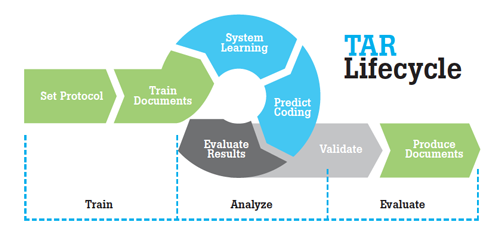Also known as “predictive coding,” TAR can significantly reduce the time and cost of document review services in litigation, investigations and other document-intensive matters.
As the reviewer codes documents, the system looks at the coding decisions of the reviewer and attempts to replicate this going forward.
TAR in the context of a live case:

TAR is now so widely used in e-discovery and so widely accepted in the US, that that one judge labelled it “black letter law”, giving it the same level of legal credibility as other long-standing legal doctrines.
Recent studies have it sought to determine whether there was a benefit to adopting a human review or whether computer systems could be relied on to produce comparable results.
The results were very interesting and further upset conventional wisdom by concluding that on every measure, the performance of the two computer systems was at least as accurate as that of human re-review.
In 2010 there was a publication of a study comparing the results of computer-assisted review to manual review. The study, Document Categorization in Legal Electronic Discovery: Computer Classification vs. Manual Review, was conducted by Kershaw along with Herbert L. Roitblat and Patrick Oot, who were all at the time affiliated with the Electronic Discovery Institute. The study concluded that; “Overall, the myth that exhaustive manual review is the most effective—and therefore the most defensible—approach to document review is strongly refuted,” they wrote in the Richmond Journal of Law and Technology. “Technology-assisted review can yield more accurate results than exhaustive manual review, with much lower effort.”
Their study found that TAR produced a 50-fold savings in cost over manual review.
For lawyers and clients facing increasing e-discovery costs, this was significant. It provided evidence that TAR could be both more effective than manual review and also significantly cheaper. But even with this evidence, many lawyers still saw one big obstacle to using TAR: the uncertainty of its acceptability to the courts.
This was significantly lowered in 2012, when Judge Peck issued his opinion endorsing the use of TAR in a case pending before him. In Da Silva Moore v. Publicis Groupe, it was the first judicial opinion anywhere to endorse the use of TAR. “Computer-assisted review appears to be better than the available alternatives, and thus should be used in appropriate cases,” he wrote, opening the door to a sea of change in how lawyers conduct e-discovery.
Furthermore, In 2013, two e-discovery researchers, Maura R. Grossman, counsel at Wachtell, Lipton, Rosen & Katz, and Gordon V. Cormack, co-director of the Information Retrieval Group at the University of Waterloo, concluded that TAR was not only more effective than human review at finding relevant documents, but also much cheaper.




